Stores Ref. A1/AA 5079? Carrier, implement, entrenching, 1939 Pattern

 European carriers for the Linneman tool were all leather, so Mills designed a matching web version for Patt. ’37 W.E. Introduced by L. of C. §B3283, it comprised two rectangular webbing pieces, stitched together, with angle buckle chapes carrying "Buckles, brass, 1-in.". An angled web strap was stitched to the front of the Carrier, with a buckle and chape opposite. The strap was long enough to be turned once around the Helve. Unlike the Tool, coding was under Section A1, but the Carrier was not “Patt. ’37 W.E.”.
European carriers for the Linneman tool were all leather, so Mills designed a matching web version for Patt. ’37 W.E. Introduced by L. of C. §B3283, it comprised two rectangular webbing pieces, stitched together, with angle buckle chapes carrying "Buckles, brass, 1-in.". An angled web strap was stitched to the front of the Carrier, with a buckle and chape opposite. The strap was long enough to be turned once around the Helve. Unlike the Tool, coding was under Section A1, but the Carrier was not “Patt. ’37 W.E.”.
To use modern marketing terminology, the Unique Selling Point of Patt. ’37 W.E. was the absence of equipment below the belt line, avoiding interference with the wearer’s legs. This did assume a Battle Order that placed the Water bottle in its Carrier inside the Haversack, this being transferred from the side to the wearer’s back. The fact that the long Patt. ’07 Bayonet, now Bayonet, No. 1 still hung well below the belt! When the Patt. ’39 tool was then added to the load, it hung down against the right leg, usually with the Water bottle carrier still being carried there. It must finally have dawned that this was far from ideal. L. of C. §B5409, approved 22 July, 1941 made the Patt. ’39 tool obsolescent, but no corresponding L. of C. for the Carrier’s obsolescence has been found.
With regard to the Stores Ref., two temptingly available codes, AA 5079 and 5080 are “available” – if the Army allocated these in a sequence prior to AA 5081 (see below). There is a problem – this leaves only one code for the two items, Head and Helve carriers described immediately below…! Codes were not marked on webbing at this time, so the answer lies in “documentation”…
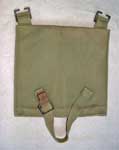
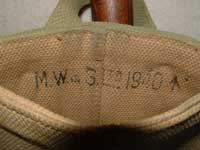 The example shown above left is unmarked and undated. From the Roger Dennis Collection. Photos © Roger Dennis 2009. The blancoed example directly left is maker marked "M.W. & S. Ltd." and dated 1940. From the Allen Prior Collection. Photos © Allen Prior 2009.
The example shown above left is unmarked and undated. From the Roger Dennis Collection. Photos © Roger Dennis 2009. The blancoed example directly left is maker marked "M.W. & S. Ltd." and dated 1940. From the Allen Prior Collection. Photos © Allen Prior 2009.
Stores Ref. A1/AA 5080? Carrier, head, implement, entrenching, Patt. ’08, N.P.
Stores Ref. A1/AA 5080? Carrier, helve, implement, entrenching, Patt. ’08, N.P.
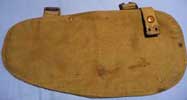

 No documentation shows these nomenclatures, which are surmised, being extrapolated from logical terms, but modified to make them discrete from the 1909 designs. “N.P.” was used in nomenclatures to indicate a “New Pattern”, which these are. The Stores Refs. are not known (see above), but it is possible the same code was used on both – a kind of “Assembly Code”, as with the so-called “Airborne Frog”, since both items were required. The example shown was made by M. Wright & Sons in 1940. From the Paul Winter Collection, photos © Paul Winter, 2009.
No documentation shows these nomenclatures, which are surmised, being extrapolated from logical terms, but modified to make them discrete from the 1909 designs. “N.P.” was used in nomenclatures to indicate a “New Pattern”, which these are. The Stores Refs. are not known (see above), but it is possible the same code was used on both – a kind of “Assembly Code”, as with the so-called “Airborne Frog”, since both items were required. The example shown was made by M. Wright & Sons in 1940. From the Paul Winter Collection, photos © Paul Winter, 2009.
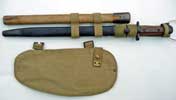
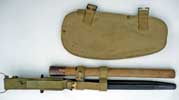 There was evidently a brief hiatus where straight-line thinking simply re-designed the old Patt. ’08 W.E. Carriers for Head and Helve and an example is known from 1940. The top loop of the Helve carrier was reversed, so that its opening was against the wearer’s leg. This mated, as with Patt. ’08 W.E., to a tab on a modified Patt. ’37 W.E. Frog. The Patt. ’08 Head carrier had been intended for wear on the right hip, underneath the Water bottle carrier. However, many transferred it to the rear Belt extensions, where it hung across the buttocks. Some wore the Carrier attached from the extension straps on the Cartridge Carriers, evidently taking the more long term view on their procreational futures! Since attachment at the rear became the norm, the new design of Head carrier had angled 1-inch buckle chapes, to align better with the crossed Brace ends. Closure of the Carrier was with a 1-inch buckle, as with the last issue of Patt. ’08 Head carrier. The example shown was made by M. Wright & Sons in 1940. The assembled Head & Helve carriers are from the Graham Priest Collection. Photos © Graham Priest, 2009.
There was evidently a brief hiatus where straight-line thinking simply re-designed the old Patt. ’08 W.E. Carriers for Head and Helve and an example is known from 1940. The top loop of the Helve carrier was reversed, so that its opening was against the wearer’s leg. This mated, as with Patt. ’08 W.E., to a tab on a modified Patt. ’37 W.E. Frog. The Patt. ’08 Head carrier had been intended for wear on the right hip, underneath the Water bottle carrier. However, many transferred it to the rear Belt extensions, where it hung across the buttocks. Some wore the Carrier attached from the extension straps on the Cartridge Carriers, evidently taking the more long term view on their procreational futures! Since attachment at the rear became the norm, the new design of Head carrier had angled 1-inch buckle chapes, to align better with the crossed Brace ends. Closure of the Carrier was with a 1-inch buckle, as with the last issue of Patt. ’08 Head carrier. The example shown was made by M. Wright & Sons in 1940. The assembled Head & Helve carriers are from the Graham Priest Collection. Photos © Graham Priest, 2009.
Stores Ref. A1/AA 5081 Carrier, implement, entrenching, Patt. ’37 (1st. Issue)
Stores Ref. A1/AA 5081 Carrier, implement, entrenching, Patt. ’37 (2nd. Issue)
Stores Ref. CN/AA 0564 Web Equipment, Patt. ’37, Carrier, implement, entrenching
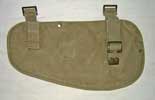
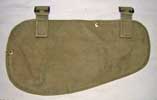 Note that this did not have a “Patt. ’37 W.E.” nomenclature. The separate Carriers were dispensed with, it having occurred – at last – to add loops to the front face of the Head carrier and extend the securing strap to close over the thick end of the Helve, the 1-inch buckle being correspondingly lower. The angled buckle chapes were also set in a vertical alignment. The example shown here is maker marked "M.E. Co." and dated 1943.
Note that this did not have a “Patt. ’37 W.E.” nomenclature. The separate Carriers were dispensed with, it having occurred – at last – to add loops to the front face of the Head carrier and extend the securing strap to close over the thick end of the Helve, the 1-inch buckle being correspondingly lower. The angled buckle chapes were also set in a vertical alignment. The example shown here is maker marked "M.E. Co." and dated 1943.
 Another view of the same 1st issue Carrier, this time assembled with an Implement, entrenching, Patt. ’08, head, Mark II, and an Implement, entrenching, Patt. ’08, helve.
Another view of the same 1st issue Carrier, this time assembled with an Implement, entrenching, Patt. ’08, head, Mark II, and an Implement, entrenching, Patt. ’08, helve.
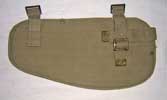

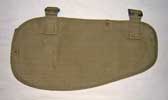 This Carrier saw service to the end of the War and beyond, but in 1945, A.C.I. 275 authorised a modification, to prevent the Helve working loose. A transverse strap, with the crown half of a press fastener, was stitched behind the front edge of the opening in the Carrier. A standard press stud spigot was added too the adjacent Helve loop and future manufacture was to be to this revised standard. The original A.C.I. contained a dimensional error, which was corrected by A.C.I. 552/1945. It's worth noting that this version of the Carrier is often referred to as the "Airborne" Tool carrier. The truth is that there is no evidence that it had any special Airborne connection, and this reference has to be marked down to wishful thinking and sales puffery. The example shown here is maker marked "M.E. Co." and dated 1945.
This Carrier saw service to the end of the War and beyond, but in 1945, A.C.I. 275 authorised a modification, to prevent the Helve working loose. A transverse strap, with the crown half of a press fastener, was stitched behind the front edge of the opening in the Carrier. A standard press stud spigot was added too the adjacent Helve loop and future manufacture was to be to this revised standard. The original A.C.I. contained a dimensional error, which was corrected by A.C.I. 552/1945. It's worth noting that this version of the Carrier is often referred to as the "Airborne" Tool carrier. The truth is that there is no evidence that it had any special Airborne connection, and this reference has to be marked down to wishful thinking and sales puffery. The example shown here is maker marked "M.E. Co." and dated 1945.
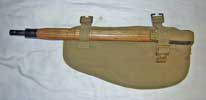 The 2nd issue Carrier shown above, assembled with an Implement, entrenching, Patt. ’37, head and Implement, entrenching, Patt. ’37, helve, Mark II, complete with bayonet adaptor.
The 2nd issue Carrier shown above, assembled with an Implement, entrenching, Patt. ’37, head and Implement, entrenching, Patt. ’37, helve, Mark II, complete with bayonet adaptor.
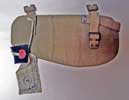
 An interesting Sealed Working Pattern example of this Carrier. Maker marked "M.E. Co." and dated 1941, it was originally sealed as a Working Pattern for the first issue, then later upgrade to second issue status and resealed. From the Graham Priest Collection. Photos © Graham Priest, 2009.
An interesting Sealed Working Pattern example of this Carrier. Maker marked "M.E. Co." and dated 1941, it was originally sealed as a Working Pattern for the first issue, then later upgrade to second issue status and resealed. From the Graham Priest Collection. Photos © Graham Priest, 2009.
In 1951, L. of C. C 4686 finally made the Carrier an official part of “W.E., Patt. ’37”. Its wartime 5000 series code was changed to one in the new C.C.N. Section CN. It was not clarified whether this was the original Carrier, or the 1945 modified version, though it should have been the latter. Very inconsiderately, the Army did not allocate a new code to the modified version, so “1st and 2nd Issue” have to suffice.
L. of C. §C6024, approved in 1954, revised the Patt. ’37 Entrenching tool to Mk. 1 status. No copy of the 1960 edition of C.C.N. is to hand, but that for 1965 shows no Carrier under Web Equipment Patt. ’37. It is not known whether this was because the Tool had been made obsolete, or the Carrier had been transferred back to V.A.O.S. Section J1.